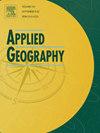The impact of the built environment on human mobility patterns during Covid-19: A study of New York City's Open Streets Program
IF 4
2区 地球科学
Q1 GEOGRAPHY
引用次数: 0
Abstract
This study uses the Open Streets Program in New York City as a natural experiment to test the effects of change in street use on foot traffic changes during COVID-19. In a two-stage-least-squares (2SLS) design, the Open Streets Program is used as an instrumental variable to isolate the exogenous effect of expanded streets for pedestrians on foot traffic patterns. We then estimate a difference-in-differences model that compares the change in foot traffic to public points-of-interests (POI) in neighborhoods that are part of the Open Streets Program with those that are not “before and after” the start of the city-wide program, in addition to other controls such as street types and weather characteristics to help reduce the error variance of the regression. We find that the Open Streets Program helped increase pedestrian activity at a neighborhood level, even when controlling for street types and other confounding temporal factors such as precipitation and temperature.
建筑环境对科维德-19 期间人类流动模式的影响:对纽约市开放街道计划的研究
本研究以纽约市的 "开放街道计划 "为自然实验,检验 COVID-19 期间街道使用变化对步行交通变化的影响。在两阶段最小二乘法(2SLS)设计中,"开放街道计划 "被用作一个工具变量,以隔离扩大行人街道对步行交通模式的外生影响。然后,我们估算了一个差分模型,比较了 "开放街道计划 "与 "全市范围计划 "启动 "前后 "未参与该计划的街区公共兴趣点(POI)的人流量变化,此外,我们还使用了其他控制因素,如街道类型和天气特征,以帮助减少回归的误差方差。我们发现,即使控制了街道类型以及降水和气温等其他时间因素,"开放街道计划 "仍有助于增加街区层面的行人活动。
本文章由计算机程序翻译,如有差异,请以英文原文为准。
求助全文
约1分钟内获得全文
求助全文
来源期刊

Applied Geography
GEOGRAPHY-
CiteScore
8.00
自引率
2.00%
发文量
134
期刊介绍:
Applied Geography is a journal devoted to the publication of research which utilizes geographic approaches (human, physical, nature-society and GIScience) to resolve human problems that have a spatial dimension. These problems may be related to the assessment, management and allocation of the world physical and/or human resources. The underlying rationale of the journal is that only through a clear understanding of the relevant societal, physical, and coupled natural-humans systems can we resolve such problems. Papers are invited on any theme involving the application of geographical theory and methodology in the resolution of human problems.
 求助内容:
求助内容: 应助结果提醒方式:
应助结果提醒方式:


